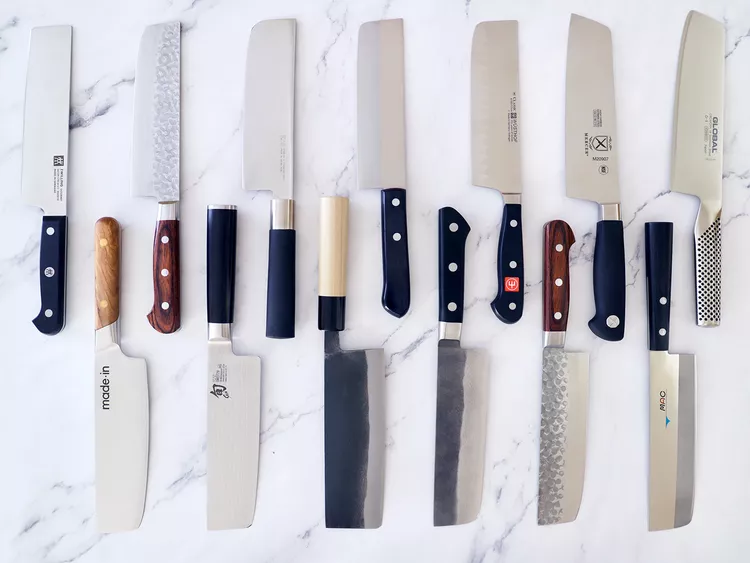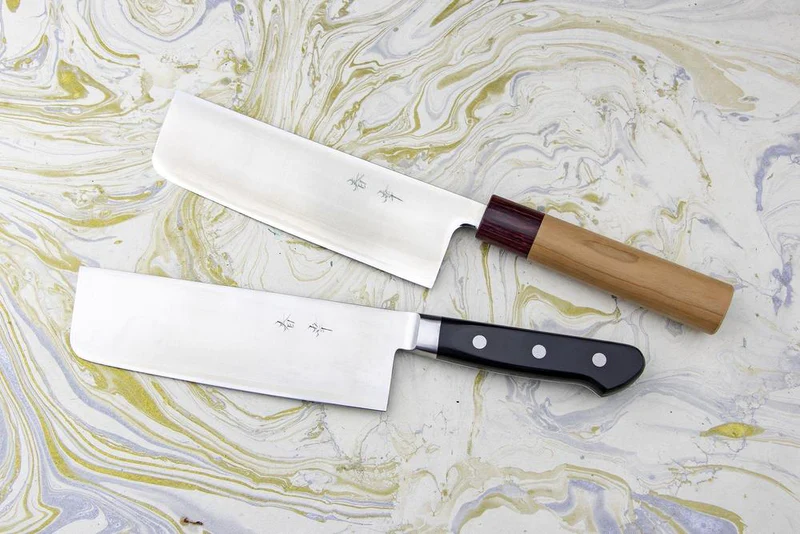Last updated on January 20th, 2024 at 02:24 am
Nakiri knives are exceptional culinary equipment. The Japanese vegetable-preparation nakiri knife is known for its precision and efficiency. This article explores the nakiri knife’s history, construction, applications, and benefits.
Understanding a nakiri knife and how it may improve your food is vital for chefs and home cooks. Let’s learn and cook!
What is a Nakiri Knife?
Japanese Nakiri Knives are used to slice and chop vegetables with precision. “Nakiri” in English means “leaf cutter” or “vegetable cutter,” describing its purpose.
This knife slices vegetables, herbs, and leafy greens precisely with a straight edge and square tip.
Origins of the Nakiri Knife
The nakiri knife has a fascinating history tied to Japanese cuisine. Japanese chefs have used the nakiri knife to create exquisite vegetable dishes for years.
The nakiri knife has changed over time, but its main purpose has remained the same: to turn vegetable preparation into a work of beauty.
Anatomy of a Nakiri Knife

Let’s examine the nakiri knife’s anatomy to appreciate its distinctive qualities:
Blade: Nakiri knives have sharp, durable carbon steel or stainless steel blades. Its straight edge allows precise cutting.
Spine: The blade’s spine is the top edge opposite the cutting edge. It aids knife control.
Tang: The blade’s handle-extending tang. Full tangs improve knife balance and stability.
Handle: Nakiri knives have magnolia or ho wood handles. It’s ergonomic and maneuverable.
Bolster: The thick juncture between the blade and handle gives the knife weight and balance.
Heel: The heel is the blade’s lowest section near the handle. It improves cutting stability.
Benefits of Using a Nakiri Knife

Nakiri knives can transform vegetable preparation. Some benefits:
Efficient and precise: The nakiri knife’s straight edge and squared-off tip enable for efficient slicing and dicing, minimizing waste and assuring consistency.
Versatility: The nakiri knife is mostly used for vegetables, but it can also cut fruits and herbs.
Visual Appeal: The nakiri knife’s crisp cuts and accurate chopping create visually appealing vegetable dishes, improving your culinary presentation.
Safety: The flat blade of the nakiri knife provides stability and control, lowering the chance of accidents and injury when slicing vegetables.
Time-Saving: The nakiri knife’s efficient cutting cuts preparation time. Its sharp blade cuts veggies easily and quickly.
Retains Flavor and Nutrients: Nakiri knives cut vegetables precisely, minimizing cell damage and preserving flavor and nutrients. This makes your dishes look good and taste fresh.
Ergonomic Design: Nakiri knives have ergonomic handles to reduce fatigue while preparing vegetables. Balanced weight distribution aids usability.
Cultural Heritage: Using a nakiri knife honors the rich cultural heritage of Japanese cuisine. It makes cooking more authentic.
How to Choose the Right Nakiri Knife

Choosing a kitchen nakiri knife involves several factors:
Blade Material: Choose a high-quality carbon steel or stainless steel nakiri knife. Carbon steel is sharp and stainless steel is durable and corrosion-resistant.
Blade Length: Nakiri knives have 6–7-inch blades. Determine the blade length based on your preferences and the vegetable sizes you work with.
Handle Design: Choose a material that feels stable and comfortable in your hand. Wooden handles are timeless and cozy, while G-10 or Micarta handles are durable and moisture-resistant.
Balance and Weight: Choose a nakiri knife with a balanced blade-handle weight. This optimizes cutting control and mobility.
Quality and Craftsmanship: Buy nakiri knives from well-known brands. This assures a long-lasting blade.
Tips for Using a Nakiri Knife

Consider these nakiri knife suggestions to optimize its benefits and ensure a safe and happy culinary experience:
Proper Grip: Use your index finger and thumb to stabilize the nakiri knife’s spine.
Correct Technique: Cut with a nakiri knife in a forward and downward motion with the blade tip touching the cutting board for precision.
Sharpening and Maintenance: Sharpen and maintain your nakiri knife. Follow the manufacturer’s cleaning and storage instructions to extend its life.
Cutting Surface: Protect the blade with a wood or plastic cutting board. Cutting against glass or ceramic dulls the knife.
Safe Storage: Keep your nakiri knife sharp and safe in a knife block, magnetic strip, or protective sheath.
Questions (FAQs)
What distinguishes nakiri and santoku knives?
The nakiri and santoku knives are multipurpose Japanese knives, yet they differ. The santoku knife can slice, dice, and chop,
while the nakiri knife is ideal for vegetable preparation with its flat blade and squared-off tip. Santoku knives have curved blades and pointy tips, making them versatile.
Nakiri knives: dishwasher-safe?
Dishwashing nakiri knives is not advised. High heat and harsh detergent harm the blade and handle. Hand-washing your nakiri knife with mild dish soap and warm water is preferable.
To prevent moisture buildup, dry the knife after washing and keep it safely.
Nakiri knives for lefties?
Lefties can use nakiri knives. Ambidextrous nakiri knives are comfortable for right- and left-handed users. Buy a nakiri knife with a left-handed handle or an ergonomic handle.
Conclusion
Finally, the nakiri knife is a unique culinary instrument that has endured. Its precision, efficiency, and veggie preparation make it a kitchen must. The nakiri knife is perfect for chefs and home cooks alike.
Understanding the origins, anatomy, benefits, and usage suggestions of the nakiri knife will help you produce beautiful, delicious vegetable-centric meals.
Let the nakiri knife become your cooking partner by embracing its cultural heritage and craftsmanship.
